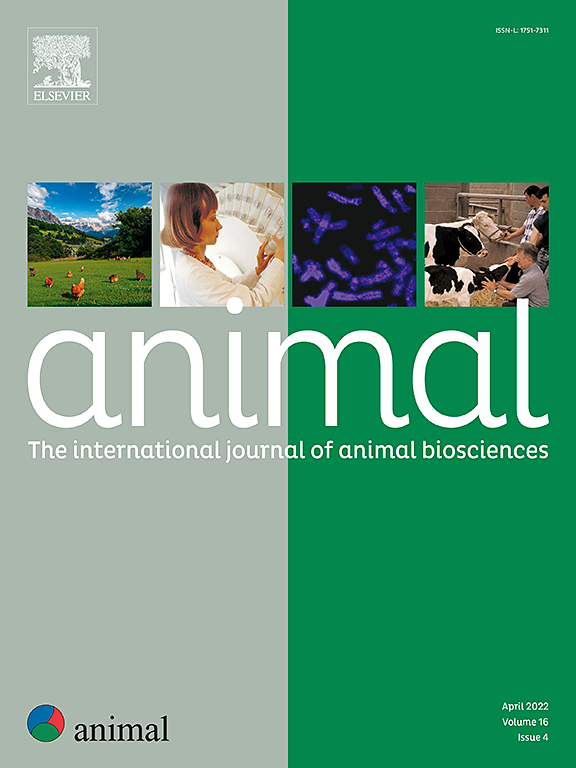对两个本土奥斯塔牛种的产奶性状进行全基因组关联研究。
IF 4
2区 农林科学
Q1 AGRICULTURE, DAIRY & ANIMAL SCIENCE
引用次数: 0
摘要
全基因组关联研究(GWAS)用于确定相关表型性状的数量性状位点。使用多焦点混合模型可以校正群体分层并考虑长程连锁不平衡。在这项研究中,研究人员对奥斯塔河谷的两个自生两用牛品种进行了基因组学分析,以确定其产奶量(产奶量、蛋白质和脂肪组成以及产量)的遗传基础。利用育种值或去回归证明,确定了产奶量、蛋白质百分比和脂肪百分比的共同重要单核苷酸多态性。在 5 号染色体和 14 号染色体上为脂肪率确定了两个主要的数量性状基因位点区域,其中包含 MGST1、CYHR1、VPS28 和 CPSF1 基因。在蛋白质百分比方面,已在 BTA 6 上确定了一个候选区域;在该区域中,注释了 CSN1S1、CSN2、HSTN、CSN3 和 RUFY3 基因。在其他关于世界性牛和本地牛的研究中,大部分已发现的基因都与牛奶成分有关。这些结果表明,涉及奥斯塔牛乳成分数量性状的基因在其他牛种中也很常见,可以利用全基因组测序数据对其进行进一步研究。本文章由计算机程序翻译,如有差异,请以英文原文为准。
Genome-wide association studies for milk production traits in two autochthonous Aosta cattle breeds
Genome-wide association studies (GWASs) are used to identify quantitative trait loci for phenotypic traits of interest. The use of multilocus mixed models allows to correct for population stratification and account for long-range linkage disequilibrium. In this study, GWASs were conducted to identify the genetic bases of milk production (milk yield, protein and fat composition, and yield) in two autochthonous dual-purpose cattle breeds from the Aosta Valley. Using either the breeding values or the deregressed proofs, common significative single nucleotide polymorphisms have been identified for milk yield, protein percentage, and fat percentage. Two major quantitative trait loci regions have been identified on the chromosomes 5 and 14 for the fat percentage, harbouring the MGST1, CYHR1, VPS28, and CPSF1 genes. For the protein percentage, a candidate region has been identified on BTA 6; in this region, the CSN1S1, CSN2, HSTN, CSN3, and RUFY3 genes are annotated. Most of the identified genes have already been associated with milk composition in other studies on cosmopolitan and local cattle. These results show that the genes involved in milk composition quantitative traits in the Aosta cattle are common also in other cattle breeds and they can be further investigated with the use of whole genome sequencing data.
求助全文
通过发布文献求助,成功后即可免费获取论文全文。
去求助
来源期刊

Animal
农林科学-奶制品与动物科学
CiteScore
7.50
自引率
2.80%
发文量
246
审稿时长
3 months
期刊介绍:
Editorial board
animal attracts the best research in animal biology and animal systems from across the spectrum of the agricultural, biomedical, and environmental sciences. It is the central element in an exciting collaboration between the British Society of Animal Science (BSAS), Institut National de la Recherche Agronomique (INRA) and the European Federation of Animal Science (EAAP) and represents a merging of three scientific journals: Animal Science; Animal Research; Reproduction, Nutrition, Development. animal publishes original cutting-edge research, ''hot'' topics and horizon-scanning reviews on animal-related aspects of the life sciences at the molecular, cellular, organ, whole animal and production system levels. The main subject areas include: breeding and genetics; nutrition; physiology and functional biology of systems; behaviour, health and welfare; farming systems, environmental impact and climate change; product quality, human health and well-being. Animal models and papers dealing with the integration of research between these topics and their impact on the environment and people are particularly welcome.
 求助内容:
求助内容: 应助结果提醒方式:
应助结果提醒方式:


